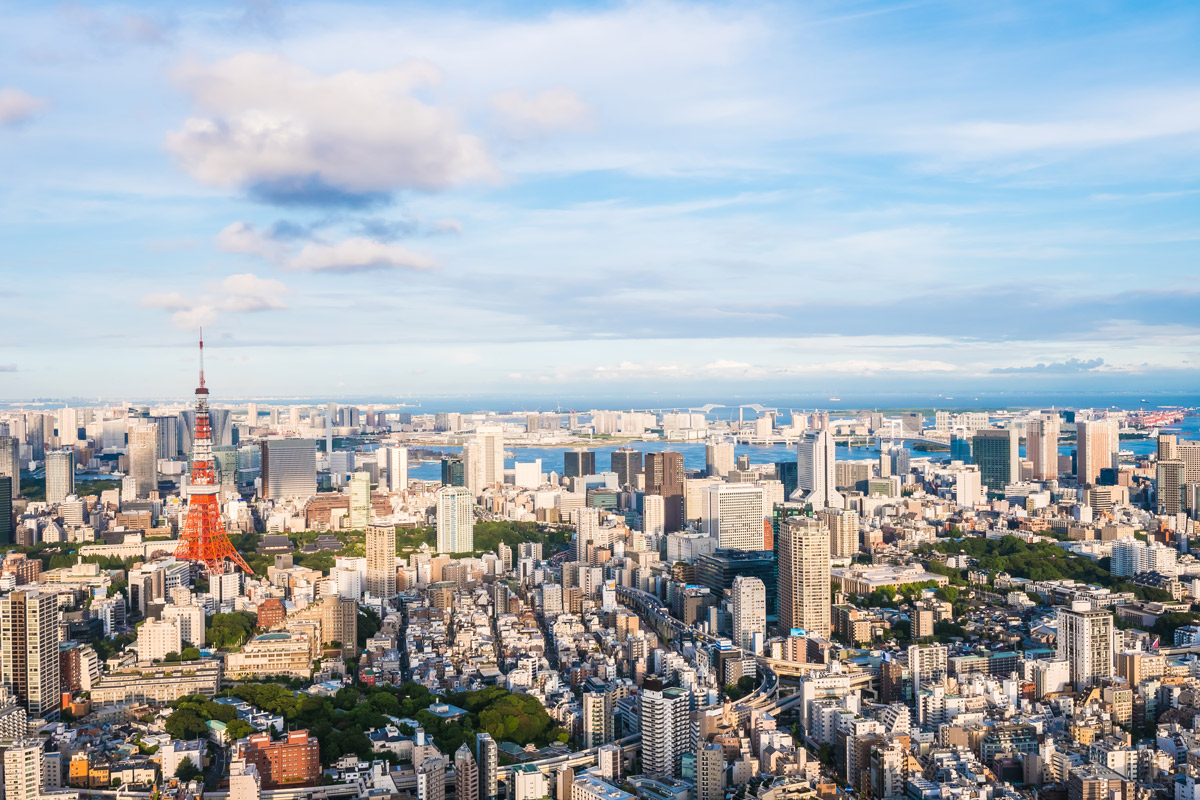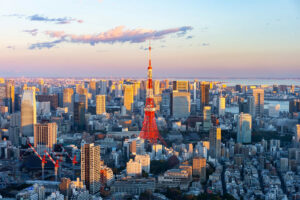Fukuoka, a vibrant gem nestled in the heart of the Kyushu region, stands as a testament to Japan’s beautiful blend of tradition and modernity. As the beating heart of the southern island of Kyushu, Fukuoka is not just a bustling hub of commerce and culture; it’s a city where history whispers from ancient temples and modern architecture soars to the sky. Straddling the banks of the River Naka, the city weaves a rich tapestry of experiences, from the historic streets of Hakata to the urban thrills of its contemporary districts.
Imagine a place where you can trace the steps of samurais in the morning at the ruins of Fukuoka Castle, and then catch a wave of futuristic excitement at Canal City Hakata, a place in Fukuoka that merges entertainment and shopping., a dazzling complex where shopping and entertainment collide spectacularly with a waterway. Fukuoka is a culinary paradise too, offering some of Japan’s best street food experiences in its bustling yatai stalls. Whether you’re savoring Hakata ramen under the neon lights or exploring the tranquil beauty of Ohori Park, this city never fails to surprise and delight.
Beyond its own charm, Fukuoka serves as a gateway to the broader wonders of Kyushu and beyond. It’s a launchpad for adventures to the historic streets of Kyoto, the lively buzz of Osaka, and the poignant memories of Hiroshima. And let’s not forget the festivals! Fukuoka’s streets come alive with vibrant events like the Hakata Gion Yamakasa, a dazzling display of parades, races, and traditional music, echoing the city’s rich cultural heritage.
So, whether you’re a history buff, a shopping enthusiast, or a foodie, Fukuoka offers a kaleidoscope of experiences. It’s a city where every corner holds a new discovery, and every visit leaves you longing for more. Join us as we explore the top tourist attractions in this dynamic city, each telling its own unique story of Fukuoka.
- 1. Canal City Hakata
- 2. Shiraito Waterfall
- 3. Fukuoka Tower
- 4. Ohori Park
- 5. Momochi Seaside Park
- 6. Kokura Castle
- 7. The Ruins of Fukuoka Castle
- 8. Dazaifu Tenmangu Shrine
- 9. ACROS Fukuoka
- 10. Hakata Station
- 11. Nokonoshima Island
- 12. Mojiko Retro
- 13. Kyushu National Museum
- 14. Marine World Uminonakamichi
- 15. Kawachi Fujien Wisteria Garden
- 15. Ukiha Inari Shrine
- 16. Fukuoka Open Top Bus
- 18. Fukuoka PayPay Dome
- 19. Fukuoka Kenei Central Park
- 20. Yame Chuo Tea Garden
- Where to Stay in Fukuoka for Sightseeing
- Frequently Asked Questions:
1. Canal City Hakata
A vibrant fusion of shopping, entertainment, and architecture, Canal City Hakata is a unique urban development that brings a touch of Venetian charm to Fukuoka.
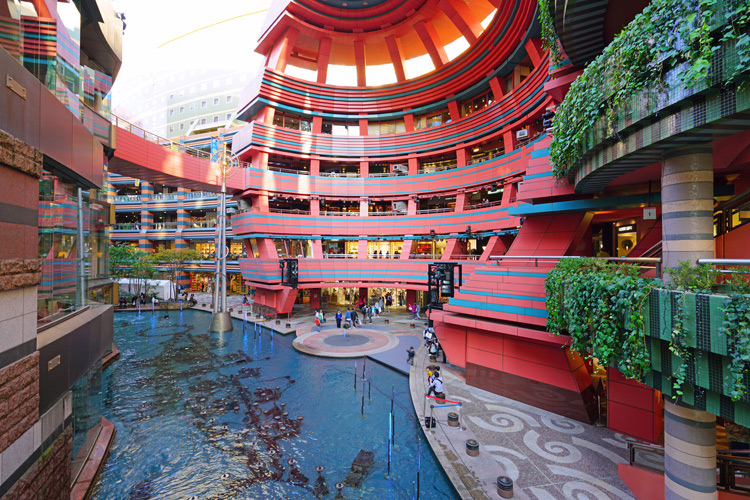
Canal City Hakata is more than a shopping mall; it’s an entertainment complex that has revolutionized the concept of urban space. Often referred to as a city within the city, it spans a vast area and is ingeniously interlaced with canals, making it a visually stunning spot.
The complex houses a wide range of shops, from high-end fashion brands to local boutiques, making it a paradise for shoppers. The dining options are equally diverse, offering everything from gourmet restaurants to street food stalls, where visitors can indulge in some of Fukuoka’s famous dishes.
Canal City’s appeal goes beyond shopping and dining. The complex hosts a variety of entertainment options, including a theater for live performances and a cinema. The centerpiece is the spectacular water fountain show, a mesmerizing dance of water and light that captivates audiences.This architectural marvel is also a hub for various events and festivals throughout the year, adding to its lively atmosphere. Its proximity to other major attractions in Fukuoka, such as the Fukuoka PayPay Dome and Nokonoshima Island, makes it a central point for tourists exploring the city.
Official Website: Canal City Hakata
For Reviews Visit: TripAdvisor
2. Shiraito Waterfall
A natural retreat known for its picturesque beauty, Shiraito Waterfall offers a serene and refreshing escape from the urban energy of Fukuoka.
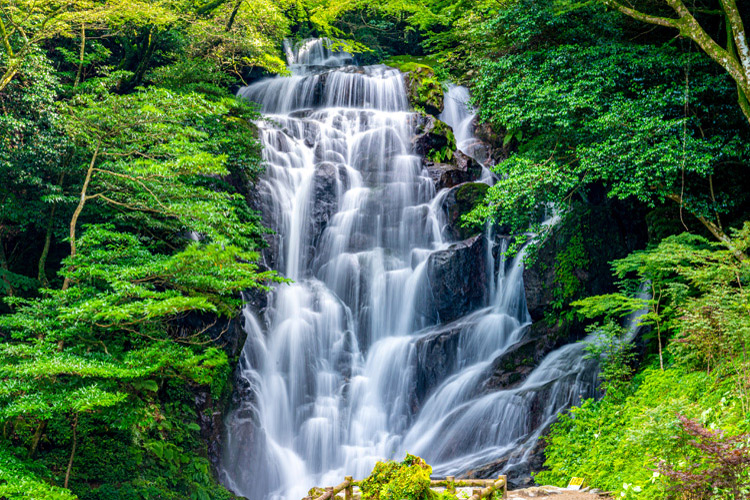
Located in the outskirts of Fukuoka, the Shiraito Waterfall is a hidden gem that exudes peace and tranquility. The waterfall, whose name means ‘white threads’, cascades gracefully over a wide rock face, creating a veil-like effect that is both soothing and visually stunning.The journey to the waterfall is an experience in itself, with hiking trails that meander through lush greenery, offering a glimpse into the region’s natural beauty. The sound of the waterfall, combined with the serene environment, makes it an ideal spot for relaxation and meditation.
Shiraito Waterfall is not just a summer retreat; each season adds a unique charm to the falls. Spring brings with it vibrant greenery, summer enhances the cool mist, autumn surrounds it with a palette of warm colors, and winter occasionally turns it into a frozen spectacle.
For travelers looking to explore more of Fukuoka’s natural attractions, Shiraito Waterfall is a must-visit. Its proximity to other scenic locations like Uminonakamichi Seaside Park and the Kawachi Fujien Wisteria Garden makes it a perfect addition to any nature-focused itinerary.
Official Website: Shiraito Waterfall
For Reviews Visit: TripAdvisor
3. Fukuoka Tower
Fukuoka’s tallest seaside tower and a symbol of the city, Fukuoka Tower offers breathtaking panoramic views and a glimpse into the region’s architectural innovation.

Dominating the city’s skyline, Fukuoka Tower is an iconic landmark standing at 234 meters tall. This mirror-clad tower reflects the city’s landscape and sky, changing its appearance with the weather and time of day. Visitors can ascend to the tower’s observation deck, which offers a 360-degree view of Fukuoka City and its surrounding areas, including the Hakata Bay and the Nokonoshima Island. The night view from the tower is particularly spectacular, with the city lights creating a mesmerizing urban nightscape.
Fukuoka Tower is not just about the views. The tower’s base features a range of facilities, including restaurants, shops, and exhibition spaces, making it a versatile attraction for all ages. It’s a popular spot for romantic dates, especially in the evening when the tower is beautifully illuminated.
The tower’s location in the Momochi Seaside Park area makes it a convenient stop for visitors exploring nearby attractions like the Fukuoka City Museum and Momochi Seaside Park itself. With its blend of architectural beauty and scenic views, Fukuoka Tower is a testament to the city’s modern charm and a must-visit for anyone touring Fukuoka.
Official Website: Fukuoka Tower
For Reviews Visit: TripAdvisor
4. Ohori Park
A serene oasis in the heart of Fukuoka, Ohori Park is a picturesque expanse of water and greenery, offering a peaceful retreat and a variety of recreational activities.

Ohori Park, with its expansive central lake, is a haven for relaxation and leisure in the bustling city of Fukuoka. Originally part of the moat system for Fukuoka Castle, the park’s name, meaning “large moat,” speaks to its historical significance. The large lake, encircled by a 2-kilometer jogging and walking path, is the park’s centerpiece, providing a scenic route for fitness enthusiasts and casual strollers alike.
The park is not just a recreational space but also a cultural hub, with the Fukuoka Art Museum located at its edge. Visitors can enjoy exhibitions of both contemporary and traditional art, making the park a blend of natural beauty and artistic expression. One of the park’s standout features is its Japanese garden, an impeccably landscaped area that offers a tranquil escape with its traditional tea houses, ornamental ponds, and seasonal flora. The garden is particularly beautiful during cherry blossom season, drawing visitors from all over to partake in hanami (flower viewing).
Ohori Park’s location makes it a convenient spot for visitors exploring nearby attractions like the ruins of Fukuoka Castle and the vibrant Nakasu District, known for its food stalls and nightlife. With its natural beauty and calm ambiance, Ohori Park is a cherished green space in Fukuoka, providing a refreshing break from the urban environment.
Official Website: Ohori Park
For Reviews Visit: TripAdvisor
5. Momochi Seaside Park
A contemporary coastal getaway, Momochi Seaside Park offers a delightful blend of beachside leisure, modern architecture, and panoramic city views, making it a symbol of Fukuoka’s urban charm.

Situated along the coast, Momochi Seaside Park is an urban beachfront that embodies the harmonious blend of nature and modernity. The park is renowned for its sandy beach, providing a perfect spot for sunbathing, swimming, and various beach sports.
One of the park’s most iconic landmarks is the Fukuoka Tower, which offers a panoramic view of the cityscape and the Hakata Bay. The park is also home to the Fukuoka Dome, a major venue for sports and entertainment events, adding to the area’s lively atmosphere.
The Sea Hawk Hotel complex, with its array of restaurants and shops, adds to the park’s allure as a destination for both relaxation and entertainment. The park’s waterfront is ideal for strolling and enjoying the ocean breeze, while the green spaces offer spots for picnics and family gatherings. Seasonal events, including fireworks and music festivals, transform the park into a vibrant hub of activity, drawing locals and tourists alike. Momochi Seaside Park is not just a beach; it’s a lifestyle destination that offers a glimpse into Fukuoka’s contemporary urban culture.
Official Website: Momochi Seaside Park
For Reviews Visit: TripAdvisor
6. Kokura Castle
A historical fortress with a rich samurai legacy, Kokura Castle stands as a proud symbol of the region’s feudal past, offering insights into the architectural and cultural heritage of Fukuoka.

Kokura Castle is a testament to Fukuoka’s rich samurai history, originally built in the early 17th century. Though the current structure is a reconstruction, it retains the grandeur and architectural style of traditional Japanese castles. The castle’s main keep offers an interactive experience, with exhibits showcasing the history of the castle and the life of samurai warriors. The panoramic view from the top floor of the castle provides a stunning overview of Kokura and its surroundings.
Surrounding the castle is the Katsuyama Park, a peaceful space that hosts cherry blossom viewings in spring, adding to the beauty of the historical site. The park also serves as a venue for various cultural events and festivals, celebrating the region’s heritage and community spirit.
Visitors to Kokura Castle can also explore the nearby traditional Japanese garden, which features beautifully landscaped grounds, tea houses, and seasonal flora. The garden offers a tranquil retreat and a glimpse into the aesthetic principles of Japanese garden design. Kokura Castle’s blend of history, architecture, and natural beauty makes it a significant cultural landmark in Fukuoka, offering visitors a journey through time to the era of the samurai.
Official Website: Kokura Castle
For Reviews Visit: TripAdvisor
7. The Ruins of Fukuoka Castle
The remnants of Fukuoka’s largest castle, the Ruins of Fukuoka Castle, evoke the grandeur of feudal Japan, offering a historical exploration amidst scenic gardens and panoramic city views.
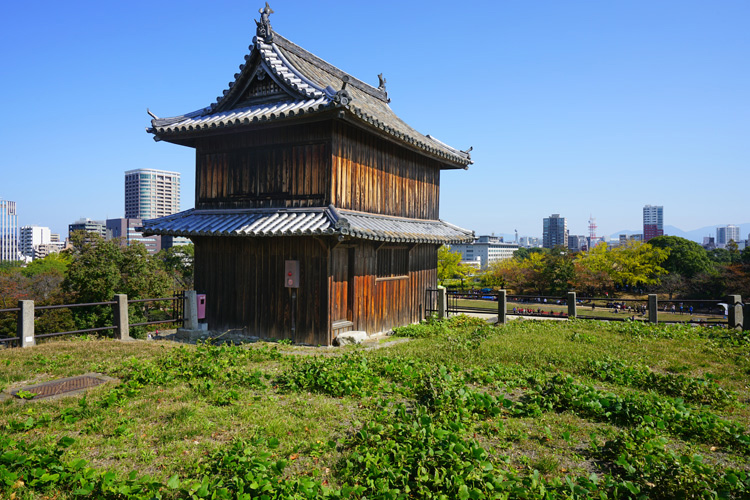
The Ruins of Fukuoka Castle, also known as Maizuru Castle, are the remains of what was once a formidable fortress in the heart of Fukuoka. Dating back to the early Edo period, the castle played a pivotal role in the region’s history and politics. Today, the ruins are spread across Maizuru Park, where visitors can explore the remnants of stone walls, gates, and yagura (turrets). The site offers a glimpse into the architectural prowess and strategic importance of the castle during its heyday.
The park surrounding the ruins is a popular spot for cherry blossom viewing, with over a thousand trees creating a breathtaking spectacle each spring. The Sakura Festival held here attracts visitors from all over, who come to enjoy the stunning display of blooms against the backdrop of the castle ruins.
The park’s elevated position provides panoramic views of the city, making it a favorite spot for photographers and sightseers. The contrast between the ancient ruins and the modern cityscape highlights Fukuoka’s ability to preserve its heritage while embracing urban development. With its historical significance and natural beauty, the Ruins of Fukuoka Castle offer a unique experience that blends cultural exploration with leisure, making it a must-visit destination in the city.
Official Website: The Ruins of Fukuoka Castle
For Reviews Visit: TripAdvisor
8. Dazaifu Tenmangu Shrine
The spiritual heart of students and scholars, surrounded by thousands of plum trees and steeped in legend.
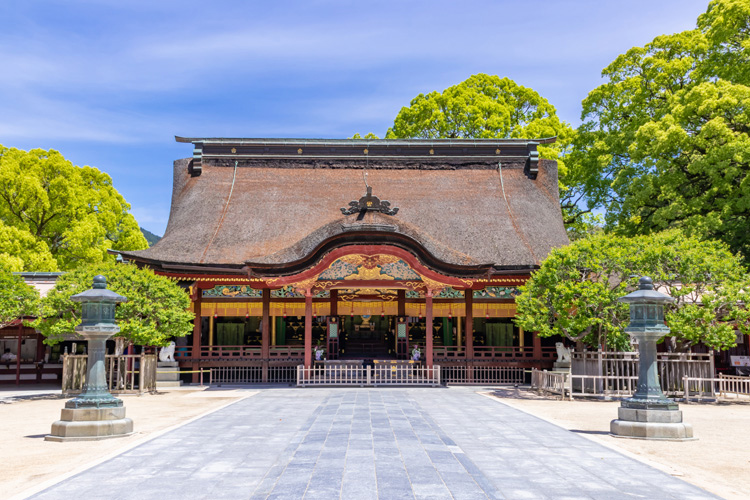
The Dazaifu Tenmangu Shrine holds a special place in the pantheon of Japan’s spiritual sites, particularly for those in pursuit of academic excellence. This shrine, dedicated to the deity of learning, Sugawara no Michizane, has been a beacon of hope for students for centuries.
The highlight here is the shrine’s architecture, which beautifully reflects the classical Japanese style, with the Main Hall designated as an Important Cultural Property. Another draw is the treasure house, which stores national treasures and important cultural properties belonging to the shrine, including calligraphy by Michizane himself.
Surrounded by over 6,000 plum trees, the shrine becomes a vision of pastel hues when these trees blossom—a sight so enchanting it can’t help but steal your breath away. It’s not just the plum blossoms that make this shrine special; the numerous lanterns that light up the path to the shrine create a mystical atmosphere that transforms the evening into a scene from a fairy tale.
Visitors are often captivated by the array of talismans and ema available, each carrying unique blessings. The shrine’s Plum Festival in February and the traditional Kyokusui-no-utage ceremony in May are highlights, offering a glimpse into Japan’s rich tapestry of cultural celebrations.
Official Website: Dazaifu Tenmangu Shrine
For Reviews Visit: TripAdvisor
9. ACROS Fukuoka
A stunning example of eco-architecture with a terraced garden that merges seamlessly with an urban environment.
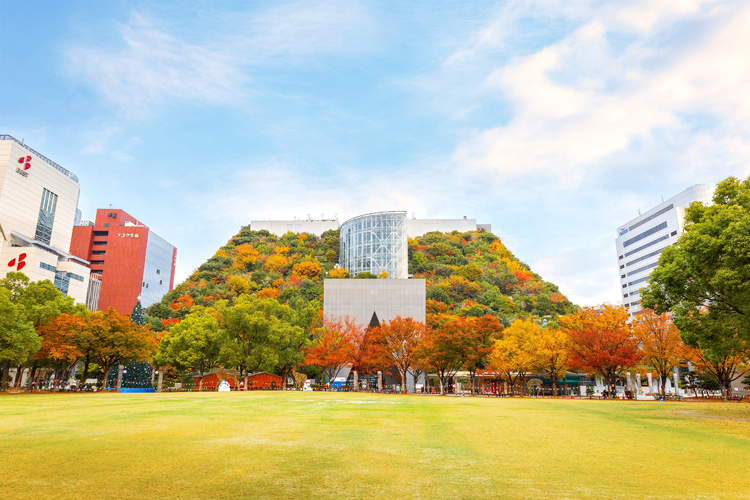
At the forefront of eco-design, ACROS Fukuoka stands tall as an urban forest in the midst of Fukuoka’s bustling city life. With its step garden that ascends fifteen stories high, it’s a verdant paradise that offers a respite from the concrete and steel of city landscapes.
The building’s design is a feat of sustainability, featuring over 35,000 plants representing 76 species. The terraces are accessible to visitors, offering not only a peaceful garden walk but also spectacular views of the city. The rooftop provides an unobstructed panorama that’s particularly breathtaking during sunset.
Inside ACROS, the Symphony Hall is renowned for its acoustics and design, providing a venue for cultural events that range from classical music concerts to modern performances. The center also hosts international conferences, contributing to Fukuoka’s global connections.
The green ethos of ACROS extends to its programming, with workshops and events focused on environmental education. It’s a place that truly embodies the harmony between nature and human ingenuity—a must-visit for those looking to see a different side of Japanese urban development.
Official Website: ACROS Fukuoka
For Reviews Visit: TripAdvisor
10. Hakata Station
A bustling nexus of travel, commerce, and cuisine, Hakata Station is more than a train station—it’s a lifestyle.
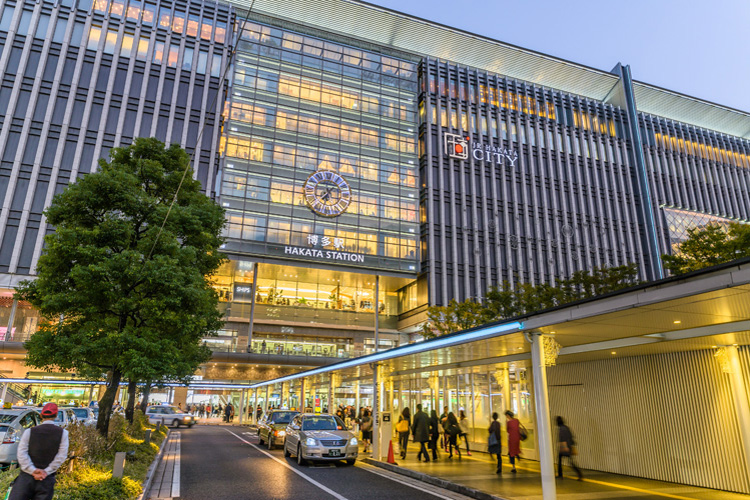
Hakata Station is a microcosm of Fukuoka’s energy, serving as the city’s main transport hub and a center of daily life. The station’s modern architecture, with its sweeping curves and expansive spaces, is a symbol of Japan’s continuing innovation in urban design.
Inside, the station is a foodie’s paradise, with myriad options from street food stalls to gourmet restaurants. The shopping opportunities are equally diverse, offering everything from local crafts to high fashion. The station’s department store, Hakata City, is a popular spot for both locals and travelers seeking to indulge in retail therapy or simply to experience the buzz of Fukuoka’s retail culture.
Hakata Station is not just a place to catch a train; it’s where you can witness the vibrancy of Fukuoka’s people. With events and exhibitions frequently taking place, it’s a cultural hub where the pulse of the city is palpable. And if you’re heading out to explore more of Kyushu or even venturing as far as Osaka or Hiroshima, Hakata Station is your gateway, connecting you to the rest of Japan with ease and efficiency.
Official Website: Hakata Station
For Reviews Visit: TripAdvisor
11. Nokonoshima Island
A natural paradise just a ferry ride away, Nokonoshima Island is a scenic escape offering stunning floral displays, recreational activities, and breathtaking views of Fukuoka Bay.

Nokonoshima Island presents a stark contrast to the urban landscape of Fukuoka. This island, accessible via a short ferry ride from the city, is a haven for nature lovers and those seeking a peaceful day trip. The island’s relatively untouched natural beauty is its main draw, with lush greenery, walking trails, and beaches that offer a respite from the bustle of city life.A major attraction on the island is the Nokonoshima Island Park, renowned for its seasonal flower displays. Spring brings a vibrant carpet of cherry blossoms and rapeseed flowers, while summer is marked by the vivid colors of sunflowers and cosmos. The park also features playgrounds, camping facilities, and barbecue areas, making it an ideal spot for family outings or group activities.
For those who appreciate art, the Noko Museum of Art, located on the island, showcases a collection of modern and contemporary art, including works by local artists. The museum’s tranquil setting complements the artistic experience, offering a blend of culture and nature.
The island also offers several vantage points for stunning views of the surrounding sea and Fukuoka’s skyline. The sunset view from the island, with the city lights twinkling in the distance, is particularly memorable, offering a moment of tranquility and reflection.
Official Website: Nokonoshima Island
For Reviews Visit: TripAdvisor
12. Mojiko Retro
A nostalgic journey to Fukuoka’s past, Mojiko Retro is a charming district that captures the historical ambiance of the Taisho and early Showa periods, featuring well-preserved buildings and a vibrant waterfront.
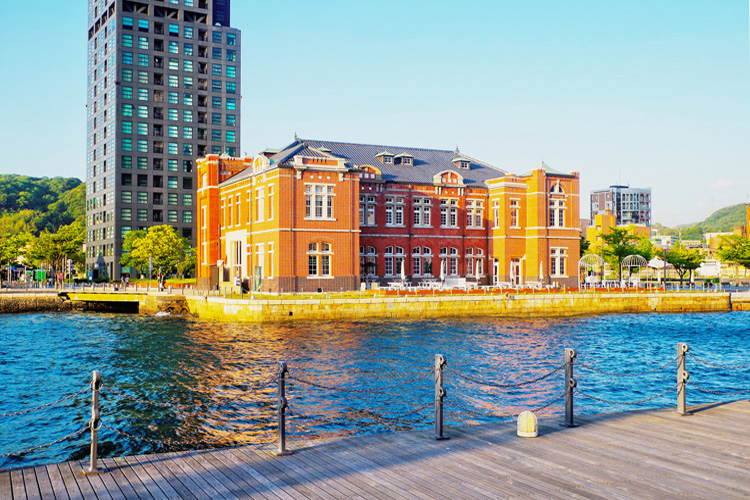
Located in the northern part of Fukuoka Prefecture, Mojiko Retro is a historic district in Kitakyushu, often regarded as an architectural time capsule. The area was an important international trade port in the early 20th century, and many of its buildings reflect this cosmopolitan past.Key attractions include the Mojiko Station, a beautiful brick building that has been restored to its 1914 glory. The nearby Old Moji Customs Building and the former Osaka Shosen Company Building are other examples of the area’s historical architecture, each telling stories of Mojiko’s prosperous past.
Visitors can stroll along the waterfront promenade, enjoying the view of the Kanmon Straits and the lively atmosphere. The area is also known for its unique shops and cafes, many of which are housed in retro-style buildings, offering a blend of historical ambiance and modern comforts.
A visit to the Kyushu Railway History Museum is a must for train enthusiasts, showcasing the evolution of Japan’s railway system. Additionally, the Mojiko Retro Observation Room in the Blue Wing Moji provides panoramic views of the straits and the surrounding cityscape, making it a perfect spot to capture the beauty of the area.With its rich history, stunning architecture, and vibrant atmosphere, Mojiko Retro offers a unique glimpse into a bygone era of Fukuoka, making it an essential visit for anyone interested in the region’s cultural and historical heritage.
Official Website: Mojiko Retro
For Reviews Visit: TripAdvisor
13. Kyushu National Museum
A modern architectural marvel, the Kyushu National Museum is not just about its vast collection, but a journey through Japan’s cultural evolution, particularly focusing on its relations with neighboring Asian countries.
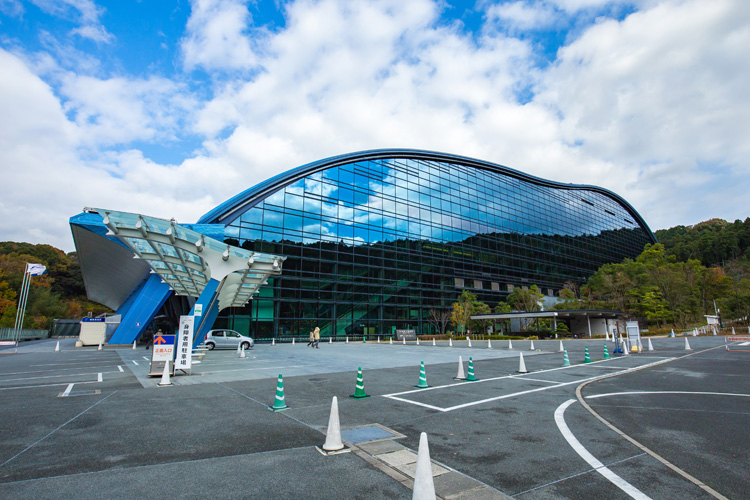
In the historical district of Dazaifu, near the famous Dazaifu Tenmangu Shrine, lies the Kyushu National Museum. Opened in 2005, it is the newest of Japan’s four national museums and stands out for its contemporary design and innovative approach to history and culture. The museum’s architecture itself is a masterpiece, with a glass façade that mirrors the surrounding natural beauty.
The museum’s exhibits are a deep dive into the history and culture of Kyushu, offering insights into the region’s role as a gateway for cultural exchange with the Asian mainland. The collections range from ancient pottery and sculptures to delicate textiles and historical documents, each piece narrating a part of Kyushu’s rich cultural tapestry.A visit here is an educational experience, where interactive displays and multimedia presentations bring to life the stories of ancient Japan and its interactions with other Asian civilizations. The museum not only showcases artifacts but also hosts special exhibitions, cultural events, and workshops that offer a deeper understanding of Japan’s history and cultural heritage.
The museum’s location in Dazaifu, a city with a history stretching back over a thousand years, adds to its appeal, making it a must-visit for anyone interested in exploring the historical roots of Japan and its connections with the broader Asian continent.
Official Website: Kyushu National Museum
For Reviews Visit: TripAdvisor
14. Marine World Uminonakamichi
An aquatic adventure awaits at Marine World Uminonakamichi, where visitors can explore the mysteries of the ocean and interact with marine life in an immersive and educational environment.
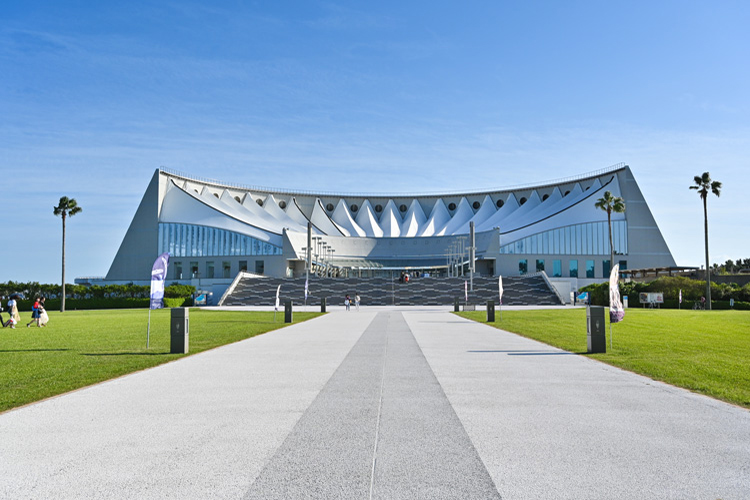
Located on the picturesque Uminonakamichi Seaside Park, Marine World Uminonakamichi is a premier aquarium that offers a fascinating glimpse into the aquatic world. The aquarium is home to a diverse range of marine life, from the vibrant coral reefs of tropical seas to the mysterious depths of the ocean.One of the major draws of Marine World is its large, panoramic tanks that provide a window into the lives of various marine species. The dynamic dolphin shows are a crowd favorite, showcasing the intelligence and agility of these beloved marine mammals. The aquarium also offers unique experiences such as touch pools, where visitors can interact directly with sea creatures like starfish and sea cucumbers.
Education is at the heart of Marine World’s mission. The aquarium conducts various educational programs and exhibitions that raise awareness about marine conservation and the importance of preserving our oceans. These initiatives provide valuable learning opportunities for visitors of all ages, fostering a deeper appreciation for marine ecosystems.
For those looking to relax and take in the scenic views, the aquarium’s ocean-facing restaurants offer a perfect spot to unwind while enjoying delicious meals with a view of Hakata Bay. Marine World Uminonakamichi, with its combination of entertainment, education, and conservation, is one of the top Fukuoka attractions for families and ocean enthusiasts.
Official Website: Marine World Uminonakamichi
For Reviews Visit: TripAdvisor
15. Kawachi Fujien Wisteria Garden
A floral masterpiece, the Kawachi Fujien Wisteria Garden is a mesmerizing display of color and fragrance, renowned for its stunning wisteria tunnels.
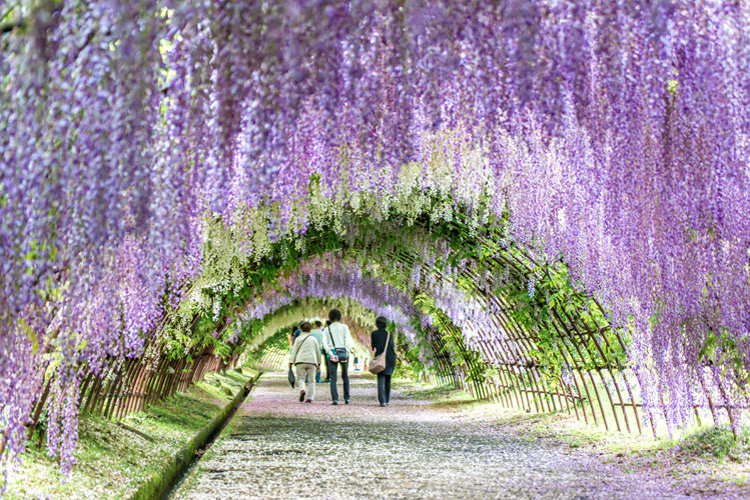
The Kawachi Fujien Wisteria Garden is a living painting that comes to vibrant life every spring. Located in the hills south of central Fukuoka, this garden is one of the most beautiful natural spectacles in Japan, drawing visitors from across the world with its enchanting wisteria tunnels that bloom in a cascading array of purples, pinks, and whites.
Walking through these flower-draped tunnels is like wandering through a fairytale, with the delicate blossoms overhead creating an ethereal canopy. The garden’s design allows for an immersive experience, with paths that guide you through the best viewing spots to stand and marvel at nature’s handiwork.
Aside from the wisteria tunnels, the garden boasts an observation deck offering panoramic views of the flowers and the surrounding landscape, making it a perfect spot for those who love to capture nature’s beauty through their lenses. During the full bloom period, the garden becomes particularly popular, so visiting early in the day can help avoid the crowds.
A visit to Kawachi Fujien is a pilgrimage for the senses, especially during the Wisteria Festival, when the flowers are at their peak. The garden’s tranquil beauty offers a serene escape and is a testament to the Japanese appreciation of the changing seasons.
Official Website: Kawachi Fujien Wisteria Garden
For Reviews Visit: TripAdvisor
15. Ukiha Inari Shrine
Ukiha Inari Shrine is a captivating spiritual site that celebrates the interplay of nature and devotion, creating a colorful tableau against the lush backdrop of Fukuoka’s countryside.

Tucked away in the verdant landscapes of Fukuoka is the Ukiha Inari Shrine, a lesser-known yet enchanting destination that captures the essence of Japan’s spiritual connection to nature. This shrine, dedicated to the Shinto god of rice and sake, Inari, is a tranquil sanctuary marked by a series of vibrant red torii gates that create a striking contrast with the surrounding greenery.
Visitors to the Ukiha Inari Shrine can meander through these gates, which trail up the hillside, offering a peaceful pilgrimage reminiscent of the famous Fushimi Inari Shrine in Kyoto. The path is lined with statues of foxes, considered messengers of the deity, enhancing the mystical feel of the shrine grounds.
The shrine is particularly beautiful during autumn when the maples turn into fiery shades of red and orange, enveloping the site in a warm glow. For travelers staying in the city, a visit to Ukiha Inari Shrine is a chance to experience the tranquility of rural Fukuoka and witness the traditional side of Japanese culture that flourishes outside the bustling city centers.
Official Website: Ukiha Inari Shrine
For Reviews Visit: TripAdvisor
16. Fukuoka Open Top Bus
The Fukuoka Open Top Bus tour is a thrilling way to witness the city’s landmarks from a fresh perspective, offering an unobstructed view of Fukuoka’s vibrant cityscape.
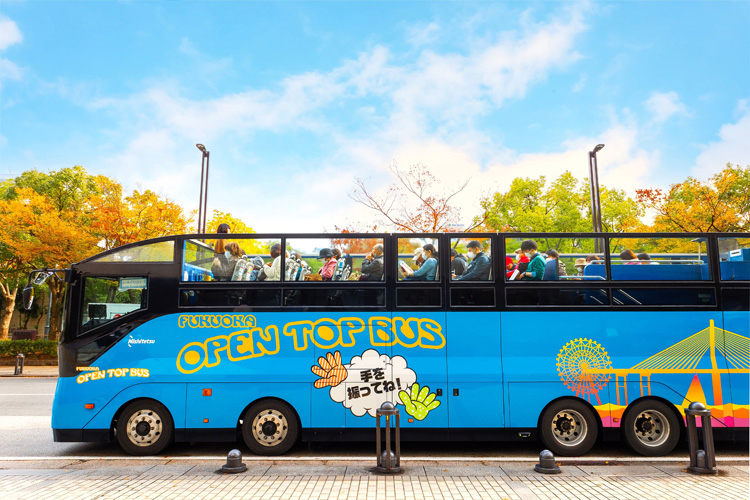
For a panoramic adventure through the heart of Fukuoka, the Fukuoka Open Top Bus provides an exhilarating open-air journey past some of the city’s most iconic sights. This hop-on, hop-off tour is perfect for visitors who want to soak in Fukuoka’s urban energy while enjoying the freedom to explore at their own pace.
As the bus winds its way through the city, passengers are treated to unobstructed views of landmarks like the majestic Fukuoka Tower, the bustling Hakata Station, and the expansive Ohori Park. It’s an ideal way to get your bearings in the city and identify spots you might want to revisit for a more in-depth exploration.
The tour guides offer insights and anecdotes about Fukuoka’s history and attractions, adding an informative layer to the sightseeing experience. Whether you’re enjoying the fresh breeze as you pass by the Momochi Seaside Park or gazing up at the modern marvels of ACROS Fukuoka, the open top bus ensures you don’t miss a thing. For those looking to capture the essence of Fukuoka, from its modern architecture to its scenic natural beauty, the open top bus is a memorable way to experience the city’s highlights and hidden gems.
Official Website: Fukuoka Open Top Bus
For Reviews Visit: TripAdvisor
18. Fukuoka PayPay Dome
A sports and entertainment landmark, Fukuoka PayPay Dome is the beating heart of Fukuoka’s athletic life and a symbol of the city’s love for baseball and large-scale events.
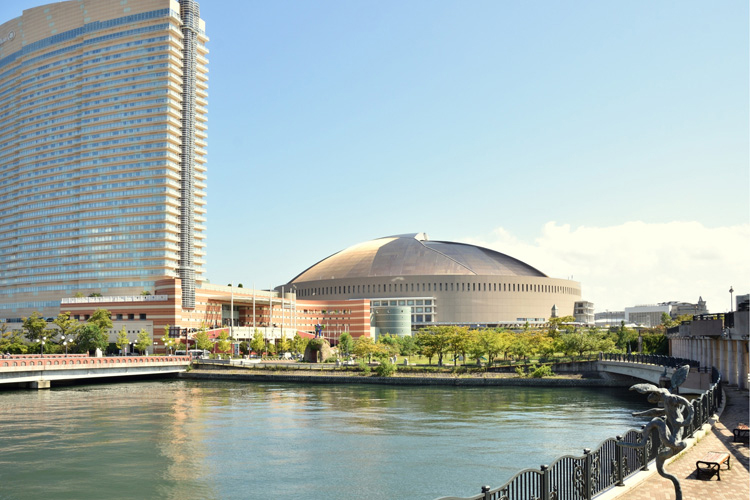
As the home of the Fukuoka SoftBank Hawks, the Fukuoka PayPay Dome is where sports fans gather to witness the thrill of professional baseball. This iconic stadium is more than just a venue for sports; it’s a cultural experience that encapsulates the passion and spirit of the local community.
With its retractable roof and state-of-the-art facilities, the Dome is an architectural marvel that hosts a variety of events beyond baseball, including concerts and exhibitions. On game days, the atmosphere is electric, with fans from all over Kyushu and beyond coming together to cheer on their teams.
The Dome’s location in the city is a boon for visitors, situated close to other attractions such as the Momochi Seaside Park and the Fukuoka Tower. For travelers, this means an opportunity to combine a day of sporting excitement with leisurely exploration of Fukuoka’s coastal beauty.
Whether you’re a die-hard baseball enthusiast or a curious traveler eager to partake in Japan’s sporting culture, a visit to the PayPay Dome is sure to be a highlight. It’s a place where the competitive spirit comes alive, and the roar of the crowd becomes the soundtrack of an unforgettable Fukuoka experience.
Official Website: Fukuoka Paypay Dome
For Reviews Visit: TripAdvisor
19. Fukuoka Kenei Central Park
An urban sanctuary, Fukuoka Kenei Central Park is the epitome of city planning where nature, leisure, and community intersect, offering a lush retreat in the heart of Fukuoka.
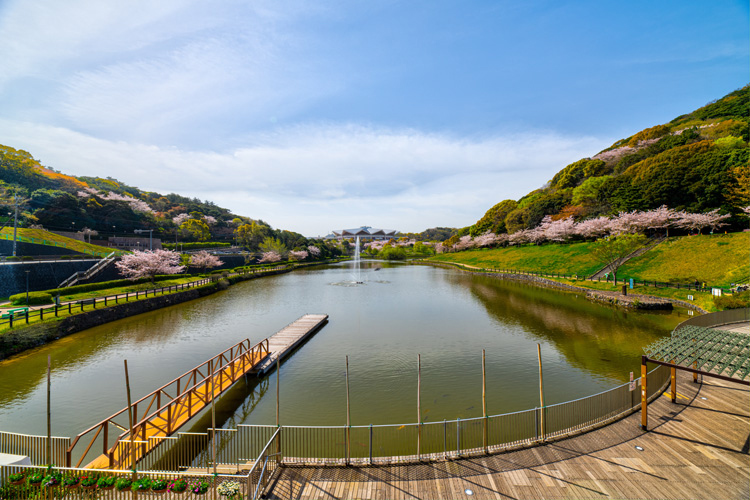
Fukuoka Kenei Central Park stands as an urban oasis amidst the city’s vibrant hustle. It’s a testament to Fukuoka’s commitment to creating green spaces where citizens and travelers alike can commune with nature. This expansive park, with its well-manicured lawns and tree-lined paths, invites you for a jog, a casual stroll, or a moment of tranquility away from the urban buzz.
Central Park is not just a place to relax; it’s a hub of activity with playgrounds for children, sports facilities, and open spaces for cultural events and festivals. It’s where locals come together to celebrate the city’s community spirit, whether through sports, picnics, or seasonal events like cherry blossom viewings, which transform the park into a wonderland of delicate pink hues.
For visitors staying at nearby hotels like The Ritz-Carlton, Fukuoka or Grand Hyatt Fukuoka, the park offers a delightful escape, a slice of nature just a short walk from the comfort of their rooms. After exploring the nearby attractions like the Canal City Hakata or the historic sites like the Fukuoka Castle Ruins, the park provides a serene endpoint to a day of exploration.
Official Website: Fukuoka Kenei Central Park
20. Yame Chuo Tea Garden
A picturesque embodiment of Japan’s tea culture, the Yame Chuo Tea Garden is a verdant expanse dedicated to the art and tradition of tea, nestled in the scenic outskirts of Fukuoka.

Venture into the countryside of Fukuoka, and you’ll find the Yame Chuo Tea Garden, a landscape steeped in the tradition of Japanese tea cultivation. Known for producing some of the finest teas in Japan, Yame is a destination for those who not only love tea but also cherish the cultural practices surrounding its production.
Visitors to the tea garden can immerse themselves in the entire tea process, from leaf to cup. The garden offers guided tours that explain the meticulous care taken in growing and harvesting tea leaves, and the artistry involved in their transformation into the perfect brew. The experience is both educational and sensory, as guests can savor the fresh aroma and flavor of Yame tea surrounded by the very plants from which it originates.
The rolling hills lined with tea bushes present a tranquil sight, offering a picturesque escape and an opportunity to learn about an integral part of Japanese culture. The tea garden is a must-visit for those looking to connect with the rural charm of the Kyushu region and enjoy one of its most cherished products.
Official Website: Yame Chuo Tea Garden
For Reviews Visit: TripAdvisor
Where to Stay in Fukuoka for Sightseeing
Let’s explore the hotel options in Fukuoka, ranging from luxury to budget-friendly, and see how they align with the city’s top attractions. This will provide a comprehensive guide for travelers looking to make the most of their stay in Fukuoka.
Luxury Hotels
The Ritz-Carlton, Fukuoka: Nestled in the heart of the city, The Ritz-Carlton redefines luxury with its impeccable service and elegant rooms. It’s perfectly situated for guests to enjoy nearby attractions like the Canal City Hakata, a shopper’s paradise, and the serene Ohori Park. After a day of exploring, the hotel’s spa offers a tranquil escape.
Kominka Neri: For those seeking a blend of luxury and traditional Japanese experience, Kominka Neri is a hidden gem. Located near the Dazaifu Tenmangu Shrine, it offers a unique stay, combining rich history with modern comfort. The proximity to the Kyushu National Museum makes it ideal for culture enthusiasts.
Yanagawa Ohana: This hotel offers a luxurious stay in a historical setting. Located in the picturesque city of Yanagawa, it’s a bit of a journey from central Fukuoka but worth it for the experience of staying in a traditional Japanese house. The boat rides along Yanagawa’s canals are a must-do.
Nipponia Hotel Yamefukushima Merchant Town: Situated in the charming town of Yame, this hotel is a journey into Japan’s cultural heart. It’s ideal for travelers who don’t mind a bit of travel to experience the traditional side of Japan, away from the bustling city life.
Hotel Cultia Dazaifu: Near the famous Dazaifu Tenmangu Shrine, this hotel offers luxury in a culturally rich environment. The hotel’s design reflects the elegance of Japanese aesthetics, making it a peaceful retreat for guests.
Mid-Range Hotels
Miyako Hotel Hakata: This hotel is a blend of comfort and convenience, located just a stone’s throw away from Hakata Station. It serves as an excellent base for exploring Fukuoka and nearby regions like Osaka and Hiroshima, thanks to its proximity to the transportation hub.
Grand Hyatt Fukuoka: Situated in the Canal City Hakata complex, the Grand Hyatt offers easy access to shopping, dining, and entertainment. It’s an ideal choice for those who want to be in the middle of the action and close to attractions like Tochoji Temple and the Fukuoka Art Museum.
Budget Hotels
Vessel Hotel Fukuoka Kaizuka: Offering comfort at an affordable price, this hotel includes breakfast and is a great choice for budget travelers. Its location in the city provides easy access to attractions like the Momochi Seaside Park and Fukuoka Tower.
Comfort Hotel Hakata: Also including breakfast, this hotel is conveniently located near Hakata Station, making it easy for guests to explore the city and beyond. The hotel’s affordability doesn’t compromise on comfort and provides easy access to Fukuoka’s main attractions.
Frequently Asked Questions:
What are some top attractions to visit in Fukuoka?
There are several must-visit attractions in Fukuoka. These include the Fukuoka Tower, Fukuoka Castle Ruins, Kushida Shrine, Japanese Garden, Fukuoka Art Museum, Hakata Gion Yamakasa, Uminonakamichi Seaside Park and the Fukuoka City Museum, among others.
Why is the Fukuoka Castle Ruins a significant attraction?
Fukuoka Castle Ruins is worth a visit due to its historical significance. The castle is located in the center of Fukuoka city, providing a glimpse into the history of Fukuoka. You can also enjoy a beautiful view of Fukuoka city from the castle ruins and Maizuru Park.
Can you tell me more about the famous Kushida Shrine in Fukuoka?
Kushida Shrine is one of the oldest and most important shrines in Japan. The shrine is famous for the Hakata Gion Yamakasa festival that takes place every July. It’s undoubtedly worth a visit during your trip to Fukuoka.
What are the best places to experience Japanese street food in Fukuoka?
Fukuoka is also famous for its food, especially the local specialty, Hakata Ramen. You’ll find many yatai (street food stalls) spread across the city, particularly in Tenjin and Nakasu districts. Fukuoka is a paradise for food lovers.
Is Fukuoka Art Museum a must-visit?
Yes, Fukuoka Art Museum is one of the major tourist attractions in Fukuoka. It houses a wide range of artwork, including iconic pieces of Asian art and contemporary art. It’s a must-visit for art lovers.
Why should one visit Hakata Gion Yamakasa?
Hakata Gion Yamakasa is one of the most significant festivals in Fukuoka held in July. The event features traditional and festive decorations and parades, making it a spectacle you don’t want to miss if you’re visiting Fukuoka in July.
What are some best things to do in Fukuoka City?
There are many fun things to do in Fukuoka city. You can explore Fukuoka Tower, enjoy the natural beauty of Seaside Park, visit Fukuoka Castle Ruins and Maizuru Park, explore the local markets or try the famous Hakata Ramen. Fukuoka City offers activities to suit everyone’s interest.
What are some best places to visit in Fukuoka Prefecture?
Fukuoka Prefecture is full of attractions. Apart from Fukuoka city, visitors should also see Dazaifu-Tenmangu, a famous shrine in Dazaifu, visit the seaside town of Itoshima, and explore the charming town of Yanagawa, known for its canals and unagi (eel) dishes.
What are some good day trips from Fukuoka?
There are many stunning places outside of Fukuoka city. You can take a day trip to Dazaifu city, visit Nanzoin Temple home to one of the world’s largest bronze Buddha statues, or you can even hop on a ferry to Uminonakamichi Seaside Park or the nearby islands.
What’s the best time to visit Fukuoka?
The best time to visit Fukuoka is in the spring (March to May) and autumn (September to November) seasons when the weather is mild and pleasant. During these periods, you can fully enjoy the outdoor attractions and local events in Fukuoka.




